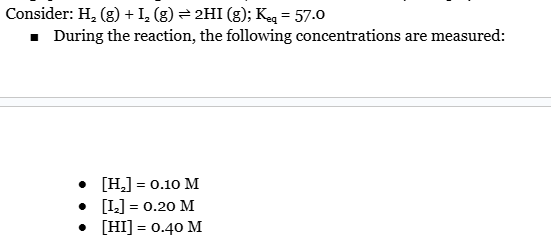Unit 7 - Equilibrium
1/32
Earn XP
Description and Tags
Covers Unit 7 of AP Chemistry (7.1-7.12) :)
Name | Mastery | Learn | Test | Matching | Spaced |
|---|
No study sessions yet.
33 Terms
Many physical and chemical changes (are/aren’t) reversible.
are
What is the definition of equilibrium?
It is a state of a reversible chemical reaction where no observable changes are occurring.
When is equilibrium reached?
It is reached when the concentrations and partial pressures remain constant and over time for both products and reactants.
When something reaches equilibrium, it doesn’t mean that nothing is changing, it instead means…
that forward and reverse reactions are occurring at the same rate.
If the rate of the forward reaction (of a reversible reaction) is greater than the reverse reaction, then…
there is a net conversion between reactants and products (reactants yield more products than products yield to reactants).
What is the reaction quotient (Q)?
It is the ratio of products to reactants of a reaction at any point in that reaction.
How can you calculate the reaction quotient?
You can calculate it using partial pressures or concentrations.
What is the general format for Q/K?
(products)^each coefficient on each product / (reactants)^each coeffieicent on each reactant.
This is just the products over reactants :)
You can only use Q/K calculations for what?
aqueous/gasses
What is the difference between Q and K?
Q can be calculated at any point during a reaction. K can only be calculated when the reaction reaches equilibrium.
What is the equilibrium constant (K)?
It measures the ratios of concentrations/pressures once a reaction reaches equilibrium at a given temperature.
At equilibrium, what is true about Q and K?
They are equal.
Why do we use the reaction quotient (Q)?
We use Q to determine HOW a reaction gets to equilibrium. Comparing Q to K will tell us if the reaction will proceed forwards or backwards.
What if Q<K?
The reaction will run forward (need more products).
What if Q>K?
The reaction will run backwards (need more reactants)
What if Q=K?
The reaction is at equilibrium

Work through this example problem and determine if the reaction runs forward, backwards, or is at equilibrium…
Substitute numbers into Q equation:
0.4²/(0.1×0.2) = 8.0
Qc = 8.0
Compare Qc to the given KC value (57)
Since Qc < Kc, the reaction runs forward (need more product)

Complete this problem, which is asking you to find the equilibrium constant KC.
Answer should be: 3.8×104

What happens if you have a very large K value (»1)?
Then the reaction will proceed to nearly completion. You’ll have a ton of product and small amount of reactants (think of that equation to help you!).
What happens if you have a very small K value («1)?
Then the reaction will barely proceed at all. You will have mostly reactants and small amounts of product.
What are the facts about manipulating Q/K? (think about multiplying, adding reactions together, and flipping a reaction)
You can treat it exactly like hess’s law. If you flip a reaction, you just flip the denominator/numerator. If you add reactions together, you multiply the Q/K value. If a reactoin is multiplied, then the K value is raised to that power (multiply by 2 means K2)
How do you calculate equilibrium concentrations?
You can do this if you know the K value, balanced equation, and initial concentrations. It’s an ICE TABLE :)
I’m not covering ICE table examples in this flashcard set, so look at the practice!!!!
okay
What does Le Chatelier’s Principle state?
States that once a system reaches equilibrium, it tends to stay at equilibrium until it is “disturbed.”
What happens to Q if you disturb a system at equilibrium by ADDING something? What will Q then do?
It will make Q differ from K and the system will “respond” to relieve that disturbance by bringing Q back to match K (this establishes a new equilibrium)!!!
What happens if you add a chemical species (reactant or product)? Does Q or K change?
Q changes
What happens if you change the temperature of a chemical reaction? Does Q or K change?
K changes
What happens if you change the volume/pressure (inversely proportional) of a chemical reaction? Does Q or K change?
Q changes
Think about this when determining which way the reaction goes:
Expand the space, expand the crowd. If you expand the space (volume), the reaction will shift to favor more moles (crowd).
What happens if you dilute a chemical reaction? Does Q or K change?
Q changes
All insoluble salts (are/aren’t) soluble…
ARE (but very very slightly hahah)
Ksp values greater than 1 indicate what?
A soluble salt that dissociates in a solution. (this means it’s dissolving)
When dealing with insoluble salts, what can Ksp be used for?
It can be used to calculate their molar solubility to determine which salts are more/less soluble.
What is the common ion effect?
It states the solubility of a salt decreases when its dissolved into a solution that already contains that salt.